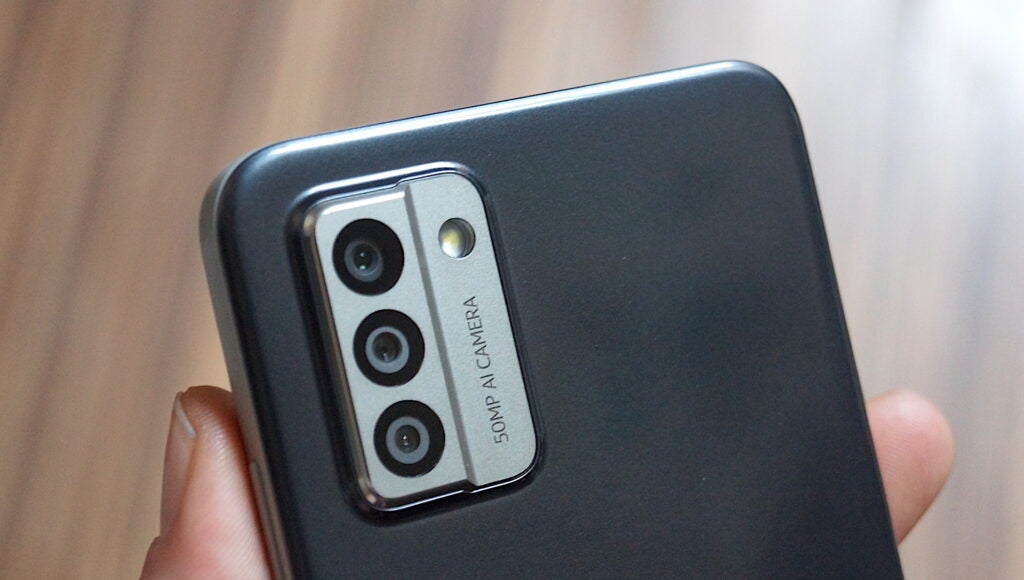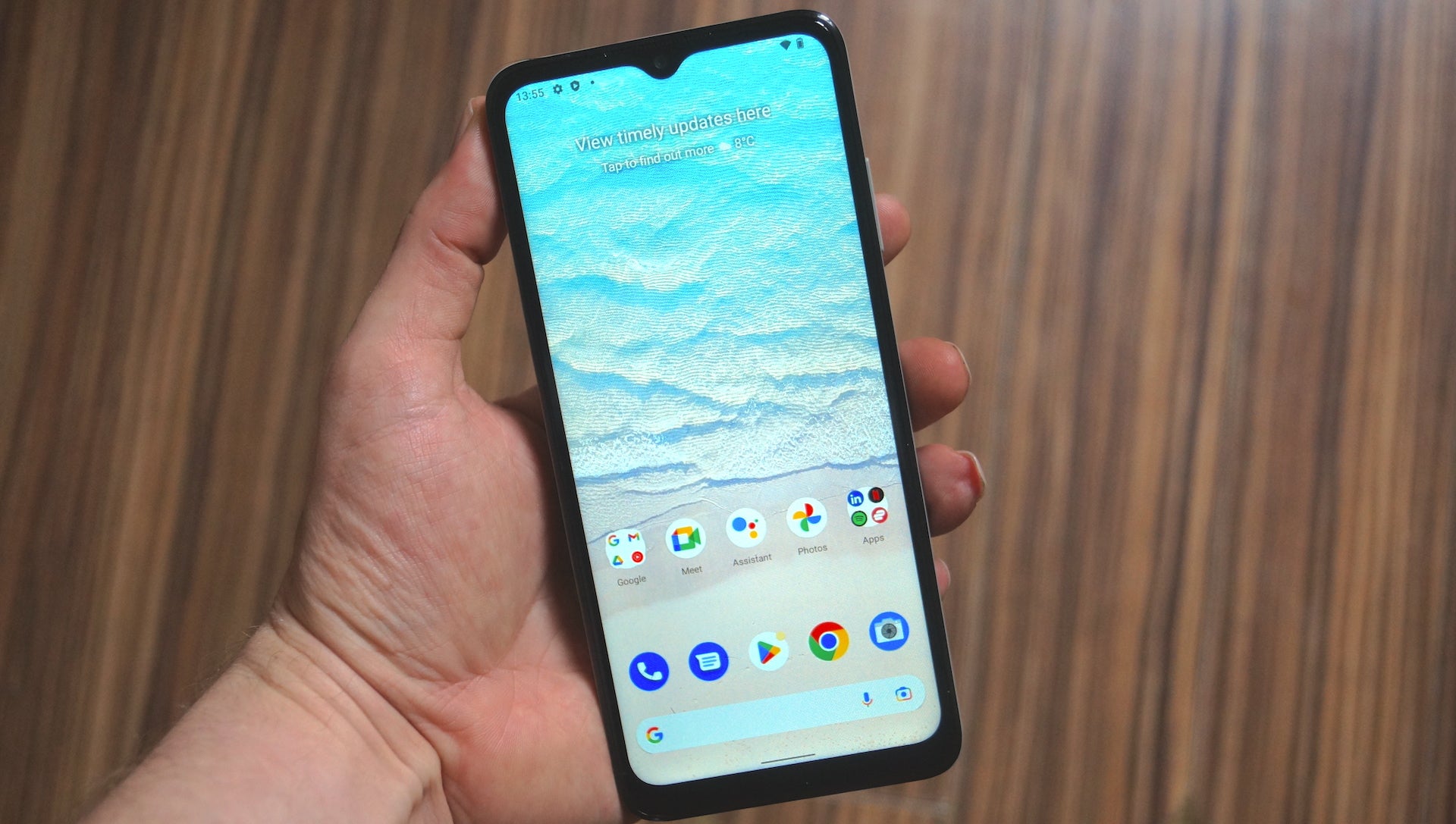Nokia should be applauded for its approach to repairability with cheap replacement parts, easily removed components and a partnership with iFixIt for guides, and it’s something that I’d love to see on more smartphones.
Introduction
The Nokia G22 may look like a standard budget smartphone, but it has a trick up its sleeve – it’s easily repairable.
Nokia focused on repairability with its latest G-series handset, making it easier than ever for consumers to replace the battery, screen and USB port – the three components that usually go wrong on smartphones – requiring only basic tools and cheap replacement parts, both provided by reputable brand iFixIt.
Repairability aside, the Nokia G22 looks to be a decent budget option with a big battery and a 50MP snapper at just £149.99. I spent some time with the Nokia G22 at a briefing ahead of its launch, and here’s what I think so far.
Design and screen
- Mostly made from plastic
- Easily repairable
- HD+ display is fine, if not a little dull
The Nokia G22 is a budget-focused smartphone, and that’s largely reflected in the overall design. It’s made mainly from plastic, including the frame that sits between the display and rear, though it does feel surprisingly robust. The use of plastic also means that it’s pretty lightweight in the hand.
That said, it does have great build quality with small features like a slightly curved rear to help the phone sit more comfortably in the hand and a display that disappears into the frame, rather than having a sharp edge like some budget options.
Nokia also claims that it’s pretty durable with the ability to survive more than 100 drops before it completely stops working.
That doesn’t really matter though. Unlike practically every other phone on the market, it’s designed to be easily repairable, further extending the life of the phone.

Nokia claims that you can swap out a battery with just a SIM ejection tool, a guitar pick and a 00 screwdriver in under five minutes – and this was demonstrated while a Nokia representative was simultaneously giving a presentation to the media. In fact, he managed it in 4 minutes and 20 seconds.
It looks really simple, with no glue sticking components down, and the company has partnered with iFixIt to provide replacement parts, tools and in-depth how-to guides.
It’s not just the battery either; you can also replace the display and the USB-C charging port with very little effort. The replacement parts are cheap too, with a battery for £22.99, a charging port for £18.99 and a display for £44.99.
That display, by the way, is a 6.5-inch panel with a HD+ resolution. That may sound disappointing on paper but in real life, text is still relatively crisp and it’s fairly bright, though colours do seem a little washed out. It is a cheap smartphone, after all, so sacrifices have to be made.

The 90Hz refresh rate does at least make things feel a little smoother in use, which is handy because it’s not exactly rapid in use. A little more on that in a bit.
Cameras
- Main 50MP rear camera
- 2MP macro lens doesn’t offer much
- Nokia-developed camera AI
Coming in at under £200, you shouldn’t expect flagship-level camera performance from the Nokia G22 – though equally, it isn’t as bad as much of the budget Android competition.
The rear camera offering is comprised of a 50MP main sensor along with a 2MP macro lens and a 2MP depth sensor. While that’s technically a dual-camera offering, the 2MP macro lens is likely just there to bump the numbers up a bit and make it look like a more tempting option. Test images I shot during my hands-on briefing with the macro lens were uninspiring and quite soft, confirming my suspicions.
The main 50MP sensor does have some promise, with Nokia claiming that it makes use of the AI algorithm that powers the more capable Nokia X30. That includes a bespoke night mode developed in-house by Nokia that it claims is much better than the budget competition, though it’s not something I could test in a bright meeting room.
That said, it does take a fairly decent photo in well-lit environments with a decent amount of detail, though the focus can be a bit hit-and-miss at times.
Flip the phone over and you’ll find a single 8MP selfie camera that should suffice for video calls on WhatsApp and the occasional selfie, but that’s about it.

Performance
- Unisoc T606 isn’t that fast
- Android 12 with 2 OS upgrades planned
- Three-day battery life
With the relatively unknown Unisoc T606 chipset at the heart of the Nokia G22, it’s safe to say it’s not a processing powerhouse – though with such a cheap price tag and the repairability taking centre stage, that’s not too much of a surprise.
That’s paired with 4GB of RAM with the phone able to take an additional 2GB of RAM from the ROM storage to boost performance when necessary, like when taking photos or attempting to play a simple game, even though the latter isn’t something I’d really recommend with the G22. It’s a handy feature, especially at the budget end of the market where RAM is traditionally rather limited.
In my brief time with the phone so far, I found the Nokia G22 to be perfectly serviceable for browsing the web via Chrome, scrolling through Instagram and sending texts, but don’t expect it to run anything particularly challenging without lag and stutter. I’ve already noticed the occasional slow-down, even with rather basic things like accessing the multitasking menu.
The G22 comes with Android 12, which is a bit of a surprise given the cheaper Nokia C22 and Nokia C32 come with Android 13 Go and Android 13 respectively.

I inquired about this and a Nokia representative explained that it’s simply because the phone has been in development for quite some time – down to the improved repairability – though they reassured me that this will be one of the last Android 12 devices from Nokia to hit the market.
It will get the Android 13 update at some point, with two OS upgrades and three years of security patches promised by Nokia, but there’s no word on when that might happen.
Still, even with Android 12, the smartphone provides a near-stock experience only really matched by the likes of Google itself and Motorola, with a clean OS free of bloatware and unnecessary features.
The phone should last for up to three days according to Nokia, and it should hold that maximum capacity for longer than many rivals. It also claims it’ll last for up to 800 cycles at maximum efficiency, compared to 500 cycles from much of the competition. Though with 20W charging speeds, it’ll likely take quite a while to go from flat to full.
Latest deals
Early Thoughts
Nokia should be applauded for its approach to repairability with cheap replacement parts, easily removed components and a partnership with iFixIt for guides, and it’s something that I’d love to see on more smartphones. That’s paired with a three-year warranty and two OS upgrades, helping users keep the phone for even longer – not bad for a sub-£150 smartphone.
Elsewhere, the 50MP camera is a nice touch, and the three-day battery life sounds promising, but I’ll reserve my final thoughts for the full review.
Jargon buster
mAh
An abbreviation for milliampere-hour and a way to express the capacity of batteries, especially smaller ones in phones. In most cases the higher the mAh, the longer the battery will last but this isn’t always the case.
IP rating
An abbreviation for ‘Ingress Protection Code’, which lets you know to what extent a device might be waterproof or dustproof.
Nokia should be applauded for its approach to repairability with cheap replacement parts, easily removed components and a partnership with iFixIt for guides, and it’s something that I’d love to see on more smartphones.
Introduction
The Nokia G22 may look like a standard budget smartphone, but it has a trick up its sleeve – it’s easily repairable.
Nokia focused on repairability with its latest G-series handset, making it easier than ever for consumers to replace the battery, screen and USB port – the three components that usually go wrong on smartphones – requiring only basic tools and cheap replacement parts, both provided by reputable brand iFixIt.
Repairability aside, the Nokia G22 looks to be a decent budget option with a big battery and a 50MP snapper at just £149.99. I spent some time with the Nokia G22 at a briefing ahead of its launch, and here’s what I think so far.
Design and screen
- Mostly made from plastic
- Easily repairable
- HD+ display is fine, if not a little dull
The Nokia G22 is a budget-focused smartphone, and that’s largely reflected in the overall design. It’s made mainly from plastic, including the frame that sits between the display and rear, though it does feel surprisingly robust. The use of plastic also means that it’s pretty lightweight in the hand.
That said, it does have great build quality with small features like a slightly curved rear to help the phone sit more comfortably in the hand and a display that disappears into the frame, rather than having a sharp edge like some budget options.
Nokia also claims that it’s pretty durable with the ability to survive more than 100 drops before it completely stops working.
That doesn’t really matter though. Unlike practically every other phone on the market, it’s designed to be easily repairable, further extending the life of the phone.

Nokia claims that you can swap out a battery with just a SIM ejection tool, a guitar pick and a 00 screwdriver in under five minutes – and this was demonstrated while a Nokia representative was simultaneously giving a presentation to the media. In fact, he managed it in 4 minutes and 20 seconds.
It looks really simple, with no glue sticking components down, and the company has partnered with iFixIt to provide replacement parts, tools and in-depth how-to guides.
It’s not just the battery either; you can also replace the display and the USB-C charging port with very little effort. The replacement parts are cheap too, with a battery for £22.99, a charging port for £18.99 and a display for £44.99.
That display, by the way, is a 6.5-inch panel with a HD+ resolution. That may sound disappointing on paper but in real life, text is still relatively crisp and it’s fairly bright, though colours do seem a little washed out. It is a cheap smartphone, after all, so sacrifices have to be made.

The 90Hz refresh rate does at least make things feel a little smoother in use, which is handy because it’s not exactly rapid in use. A little more on that in a bit.
Cameras
- Main 50MP rear camera
- 2MP macro lens doesn’t offer much
- Nokia-developed camera AI
Coming in at under £200, you shouldn’t expect flagship-level camera performance from the Nokia G22 – though equally, it isn’t as bad as much of the budget Android competition.
The rear camera offering is comprised of a 50MP main sensor along with a 2MP macro lens and a 2MP depth sensor. While that’s technically a dual-camera offering, the 2MP macro lens is likely just there to bump the numbers up a bit and make it look like a more tempting option. Test images I shot during my hands-on briefing with the macro lens were uninspiring and quite soft, confirming my suspicions.
The main 50MP sensor does have some promise, with Nokia claiming that it makes use of the AI algorithm that powers the more capable Nokia X30. That includes a bespoke night mode developed in-house by Nokia that it claims is much better than the budget competition, though it’s not something I could test in a bright meeting room.
That said, it does take a fairly decent photo in well-lit environments with a decent amount of detail, though the focus can be a bit hit-and-miss at times.
Flip the phone over and you’ll find a single 8MP selfie camera that should suffice for video calls on WhatsApp and the occasional selfie, but that’s about it.

Performance
- Unisoc T606 isn’t that fast
- Android 12 with 2 OS upgrades planned
- Three-day battery life
With the relatively unknown Unisoc T606 chipset at the heart of the Nokia G22, it’s safe to say it’s not a processing powerhouse – though with such a cheap price tag and the repairability taking centre stage, that’s not too much of a surprise.
That’s paired with 4GB of RAM with the phone able to take an additional 2GB of RAM from the ROM storage to boost performance when necessary, like when taking photos or attempting to play a simple game, even though the latter isn’t something I’d really recommend with the G22. It’s a handy feature, especially at the budget end of the market where RAM is traditionally rather limited.
In my brief time with the phone so far, I found the Nokia G22 to be perfectly serviceable for browsing the web via Chrome, scrolling through Instagram and sending texts, but don’t expect it to run anything particularly challenging without lag and stutter. I’ve already noticed the occasional slow-down, even with rather basic things like accessing the multitasking menu.
The G22 comes with Android 12, which is a bit of a surprise given the cheaper Nokia C22 and Nokia C32 come with Android 13 Go and Android 13 respectively.

I inquired about this and a Nokia representative explained that it’s simply because the phone has been in development for quite some time – down to the improved repairability – though they reassured me that this will be one of the last Android 12 devices from Nokia to hit the market.
It will get the Android 13 update at some point, with two OS upgrades and three years of security patches promised by Nokia, but there’s no word on when that might happen.
Still, even with Android 12, the smartphone provides a near-stock experience only really matched by the likes of Google itself and Motorola, with a clean OS free of bloatware and unnecessary features.
The phone should last for up to three days according to Nokia, and it should hold that maximum capacity for longer than many rivals. It also claims it’ll last for up to 800 cycles at maximum efficiency, compared to 500 cycles from much of the competition. Though with 20W charging speeds, it’ll likely take quite a while to go from flat to full.
Latest deals
Early Thoughts
Nokia should be applauded for its approach to repairability with cheap replacement parts, easily removed components and a partnership with iFixIt for guides, and it’s something that I’d love to see on more smartphones. That’s paired with a three-year warranty and two OS upgrades, helping users keep the phone for even longer – not bad for a sub-£150 smartphone.
Elsewhere, the 50MP camera is a nice touch, and the three-day battery life sounds promising, but I’ll reserve my final thoughts for the full review.
Jargon buster
mAh
An abbreviation for milliampere-hour and a way to express the capacity of batteries, especially smaller ones in phones. In most cases the higher the mAh, the longer the battery will last but this isn’t always the case.
IP rating
An abbreviation for ‘Ingress Protection Code’, which lets you know to what extent a device might be waterproof or dustproof.

























